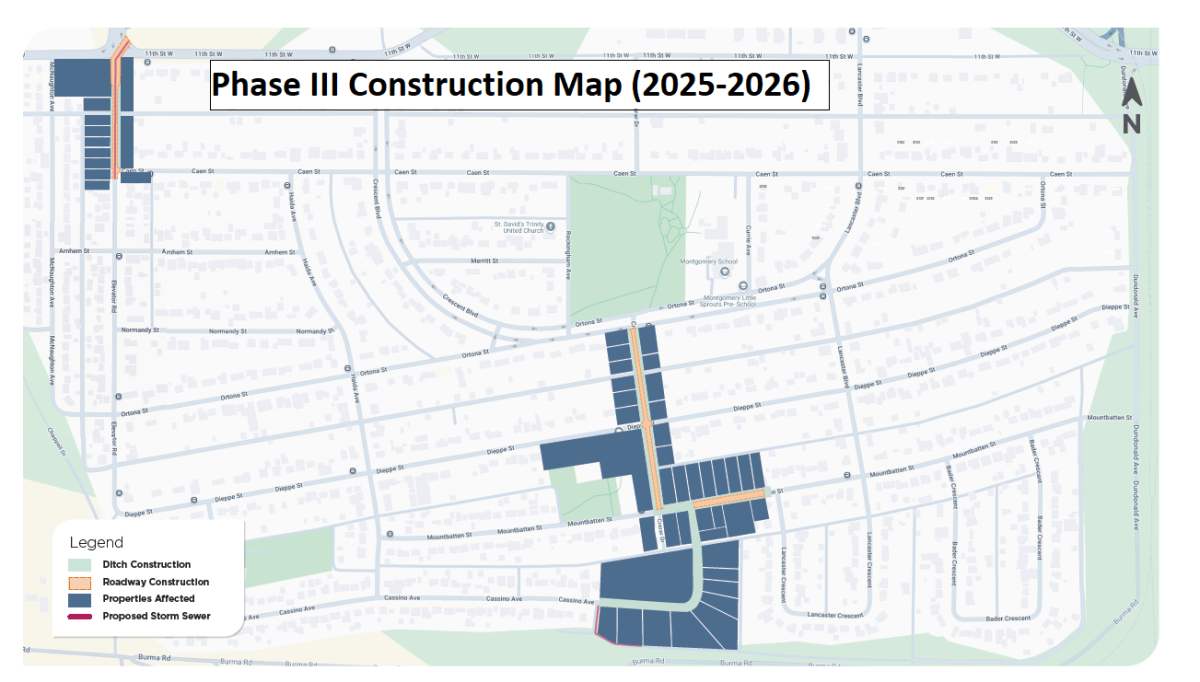What types of construction will occur?
The Montgomery Place Construction Project includes restoring ditches and culverts to provide a flow path for storm water, water main replacement, lead-line connection removal and replacement, and road reconstruction. Driveways on City-owned right-of-ways will be impacted.
Why aren’t underground storm sewers being installed instead of ditches and culverts?
The cost to install underground storm water pipes is very expensive, especially in older areas where there is other underground infrastructure. Property owners in new neighbourhoods pay for those costs through a development levy. In the past, new underground storm water pipes were included in the infrastructure proposed for Montgomery Place, to be cost-shared by citizens through a neighbourhood improvement levy. However, neighbourhood citizens rejected this proposal so the ditch and culvert system has been retained.
What are the locations of the project?
Please go to the Background tab for descriptions and maps of the locations for each construction phase.
How did the City select the locations?
The City receives complaints of flooding and damage because drainage is blocked by driveway crossings that don't have proper culverts. The City focused on the downstream end of the drainage system in Montgomery Place in Phase I and is working upstream. Phase II and III areas were also determined in collaboration with the Roadways Preservation program.
What are the construction timelines?
- Phase I: work on Lancaster Boulevard and Ortona Street will not be complete in 2022 and will carry over into 2023
- Phase II: to be completed over 2 years between 2023-2024
- Phase III: to be completed over 2 years between 2025-2026
Construction within each year is expected to occur between April and October.
During the ditch projects, can I have temporary access to my front yard while the ditch and roadway work is being constructed in front of my house?
Residents will be required to utilize the back alley or side yards to access their property during construction. For properties that do not have a back alley or side yard access, access will be determined on a case-by-case basis in collaboration with the City and the contractor.
For those residents who have mobility needs, please contact the City prior to construction beginning.
My property hasn’t flooded. Why is a ditch and culvert being installed in the right-of-way adjacent to my property?
Driveways without culverts and right-of-ways without ditches impede the flow of storm water runoff and snow melt, and contribute to flooding and damage for upstream neighbours. This project will provide a clear path for water to flow to the new catch basin being constructed on Dundonald Avenue, thereby reducing ponding and/or flooding conditions for the drainage area.
Run-off storm water storage is also required for the neighbourhood as underground storm sewers are not installed. The ditch and culverts have been designed for similar storage compared to a residential neighbourhood with underground storm sewers.
Will the trees on City of Saskatoon right-of-ways be impacted?
Tree preservation will be completed if possible. Tree preservation will cause sections of steep ditch slopes to preserve tree roots.
Why was the tree preservation a priority over the maintenance of the ditches for Phase I?
City tree protection is required under the City Council Policy: Trees on City Property.
Trees on public property and right-of-ways are valuable assets and an important part of the larger urban forest, which provides economic, environmental, and social benefits to everyone who lives in or visits Saskatoon. Protecting and maintaining City-owned trees ensure they will continue to provide these benefits will into the future.
From feedback from Phase I, the City is currently reevaluating the tree preservation approach for the Montgomery Place Drainage Improvement Project. Tree preservation discussions will be completed between the City and property owners during the private ditch crossing contract discussions.
Why are the ditch slopes for Phase I (Caen Street, Dundonald Avenue, Lancaster Boulevard) inconsistent from property to property?
Steeper sections of ditch were required to work around and preserve trees. Power poles and above ground external utility infrastructure also required steeper sections of ditch.
As per our regular process, the City has completed surveys of the constructed ditches and is evaluating if there are any areas that were constructed at a steeper grade than what was designed. Additionally, due to feedback from residents, the City completed some spot checks on the drainage ditch slopes and identified some locations that were constructed steeper than designed. The City is currently evaluating how these construction deficiencies will be rectified.






